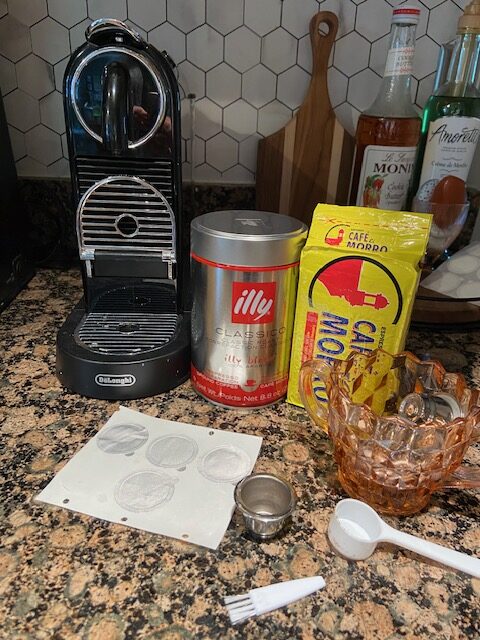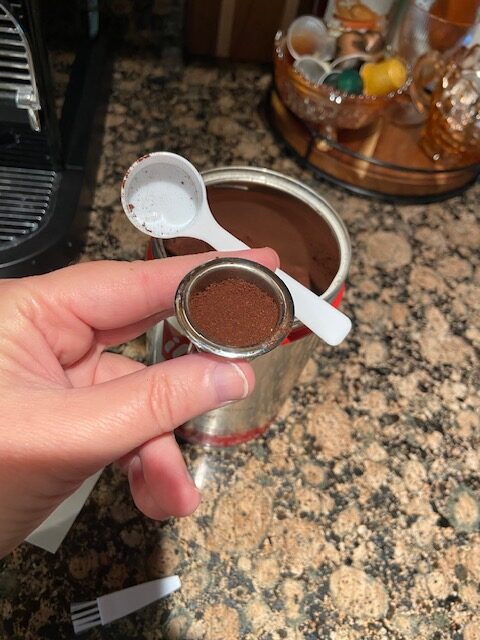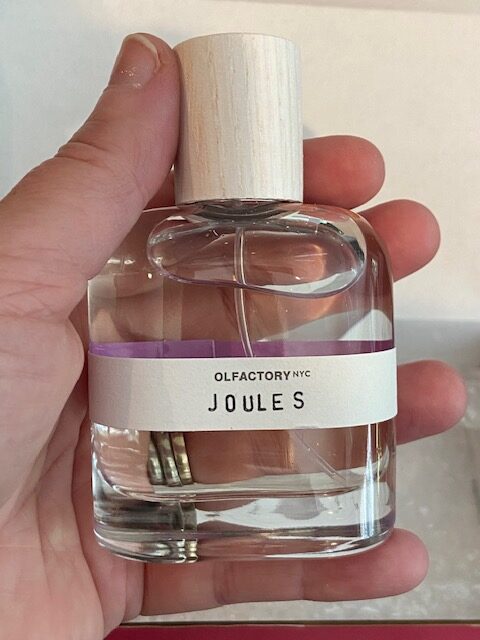A few weeks ago, I got caught in a rainstorm while out and about for work. Like a full-on drenched rain goblin. And then I ignored my hair while continuing to do work stuff for a few more hours. And then when I got home and looked in the mirror… my hair looked fantastic.
What the heck with these beachy waves. There was NO effort?! And it turned out like this???
So that reminded me that I’ve gone through phases of wearing my hair wavy over the years and I wondered if I could use the ‘curly hair method’ or ‘wavy hair method’ or just the Reddit rabbit hole to find the perfect product that could recreate this look with little effort.
Before we get into all the science experiments, my typical hair routine is that I shampoo and condition it in the shower. Then, I put it up in a towel to dry a bit while I’m getting ready. Last, I use a wide tooth comb to comb it out. It is typically tangled from being up in a towel. I’ll sometimes stick a little product in there (maybe Potion 9 or Moroccan oil) and then just let it air dry. It dries mostly straight with a little body or waves. I wash it every 2-3 days, which my dry hair likes.
For my wavy hair experiments, I started with trying to figure out what kind of hair I actually have. Now, with the *wonders* of perimenopause… my hair texture HAS been changing. For the past few years, I suddenly have little curls at my temples and a full-on wave pattern at the back of my head. After a deep dive into hair type charts, I landed on a mix of 2A/2B hair, which is wavy, fine and easily weighed down. It’s not quite straight, not full curlicues, something in the middle.
Once I know what I was working with, I did some research, ordered a few options online, and went into full science mode…
Try 1: Mizani Curl Cream and the Bowl Method
Product link: https://amzn.to/4eQHPI7
For this try, I washed and conditioned my hair like normal and then combed it with a wide-tooth comb when I got out of the shower. Then, I did “the bowl method”, where you pat on your product with “praying hands” and then dip your hair into a bowl of water and scrunch it. And dip and scrunch. And dip and scrunch. And then I kind of scrunched the extra water out with a towel and let it air dry without touching it again.
The results were pretty darn close!


Lots of waves. Very similar to my rained on hair.
Try 2: Curlsmith In Shower Fixer



Product link: https://amzn.to/3Gt7x8W
This product got rave reviews on the Wavy Hair Reddit, so I immediately hit ‘add to cart’ and waited with baited breath for it to show up at my house. (Fun fact: I actually saw it at TJ Maxx for way cheaper afterwards). For this experiment, I washed and conditioned my hair in the shower. Combed it out while still in the shower with dripping hair. Then, applied the Curlsmith In Shower Fixer with praying hands and scrunched, scrunched, scrunched. I finished up by scrunching the extra water out with an old tee shirt and letting it air dry without touching it again.
Okay, so first of all my hair dried like Ramen (left photo). I “scrunched the crunch” out but I hated the texture of my hair. It felt super goopy and the waves were more ‘grown out 90’s perm’ for me (middle photo). Also, the next morning it felt absolutely disgusting and I had to immediately wash it out of my hair (right photo).
Try 3: Cake the Curl Whip Mousse in the Shower


Product link: https://amzn.to/44EAOW4
Here is another product that people loved on the Wavy Hair Reddit! I washed and conditioned my hair in the shower. Combed it out while still in the shower with dripping hair. Then, applied the Cake the Curl Whip Mousse with praying hands and scrunched it in. I finished up by scrunching the extra water out with an old tee shirt and letting it air dry without touching it again.
It gave me light waves and felt like no product at all , which I like (left photo). It was nice for a less aggressive wave situation. And the next day hair was really good too, not many waves but really good body and texture without feeling dirty (right photo).
Try 4: Sebastian Potion 9 – The Shower Method AND the Bowl Method
Shower Method:


Product link: https://amzn.to/4622BlQ
I have literally used this product since I was 15 years old. For this experiment, I washed and conditioned my hair in the shower. Combed it out while still in the shower with dripping hair. Then, applied the Potion 9 with praying hands and scrunched it in. I finished up by scrunching the extra water out with an old tee shirt and letting it air dry. When it was dry, I separated the curls a bit by running my hands through my hair. Results: soft waves, no gunky buildup and I can easily run my fingers through my hair. Next day hair still has some waves too.
Since we were doing this For Science, I tried this exact same set up again, but this time I used the bowl method to see if there was any difference.


And they are basically the same. The in shower method is a lot easier and less messy, but gives similar results.
Here’s bowl vs shower method:


Try 5: Mizani Curl Cream and the Shower Method


Product link: https://amzn.to/4eQHPI7
After the Potion 9 gave me similar results for both the bowl and shower method, I decided to revisit the Mizani Curl Cream. This time I washed and conditioned my hair in the shower. Combed it out while still in the shower with dripping hair. Then, applied the Mizani Curl Cream with praying hands and scrunched it in. I finished up by scrunching the extra water out with a towel and letting it air dry.
Comparison:


Hardly any difference and the shower method is easier and less messy!
What I Learned:
So after all my experiments, here is where I ended up…
- Most Like Rained On Waves: Mizani Curl Cream
- Less Aggressive Waves: Sebastian Potion 9
- Few Waves, More for Body: Cake the Curl Whip Mousse
- Bonus: Water spray bottle to reactivate waves for day 2 and day 3. (I love this one https://amzn.to/40KKAVr and use it on my plants too!)
And that’s my final data for my experiments into wavy hair. Of course, in the last week it’s too hot and sticky to wear my hair down without regretting all my life decisions, so I’ve been doing all the braids. However, next time I want to activate my mermaid hair dreams, I know what to do!
Disclosure: This post contains Amazon affiliate links. This means that clicking on a link may help me earn a small commission at no cost to you.








